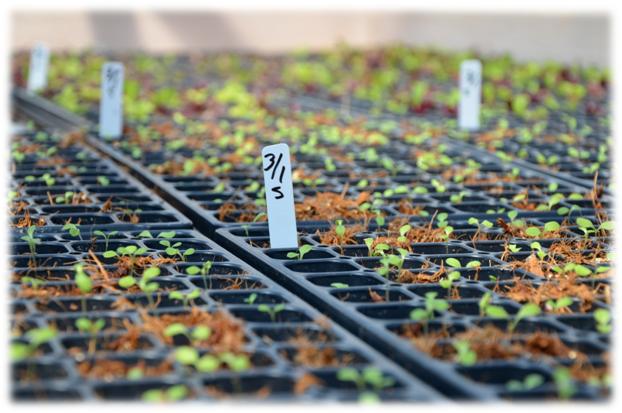Planting Strategies And Specialized Techniques For Greens Crops
It took us an embarrassingly long time to notice that tiny seedlings have completely different space requirements than fully-grown plants, and to figure out how to make this fact useful to maximize our system “real estate”. In our April 2010 training, while Tim was doing a segment of the training that I probably should have been paying attention to, I (Susanne) was instead cruising around the internet doing a Google image search for “aquaponics”, just to see what was going on through pictures. I found an intriguing photo that took me to a website about Cornell University’s Controlled Environment Agriculture (CEA) experiments growing lettuce hydroponically in greenhouses. Clearly this growing method required tremendous funding for both start-up and on-going operational expense, and in addition was very labor-intensive, but it still had some valuable information about spacing requirements from seedling stage to five-ounce harvest-sized heads of lettuce.
(Below) Seedlings in “98’s” in one of our sprouting tables. This technology we invented in 2010 puts around 10 times as many plants in a greenhouse (per square foot of greenhouse space) as the UVI technology we learned on, or than the technology offered by other aquaponic consultants (who will remain nameless because they’ve threatened to sue us).
Their method involved seeding into tiny cells in a standard nursery seeding tray that held 128 in the same area that we had been using 32 cells of 2” slit pots! This got me thinking – what would be the maximum number of seeds to sprout into the minimum amount of space? We experimented with trays that held 72 cells and trays that held 98 cells. This involved moving the sprouts into 2” slit pots, and I was concerned that they would experience some sort of transplant shock, as plants do when they are planted in pots, then moved out into the ground.
Often, this transplant shock is so severe that most of the leaves of the plant must be removed to avoid loss of moisture from the plant, as transpiration continues before the roots are established enough to take up enough water to keep the plant alive.Transplant shock did not seem to be a problem, and since October of 2010, we have been seeding in this manner. Click here for the downloadable 8-page PDF document that demonstrates this process pictorially.
Tim’s First Reaction To The High-Density Planting Technique:
Susanne spent a couple of months perfecting this high-density planting technology, then showed it to me. When I first saw the little lettuces after being “forked” into the pots in the rafts, I was certain they were all going to die! They leaned this way and that, and there was hardly any coir in the pot with the pathetic little mass of roots and tiny leaves. But they all survived and did incredibly well!
I needn’t have worried: Susanne already went through this: the little plants looked wrong at first, so she tried putting some coir in the bottom of the pot before forking in the sprout, and “tucking it in” with more coir around the sides, so it didn’t fall over and slump so badly. All this work turned out to be unnecessary; as she found out later that the technique worked just fine without it. The only trick is that you need to cover the baby plants if they’re in outdoors “nursery troughs” (which is what we call the part of the system the youngest plants are in) to keep cold heavy rain off them; or you can lose 30% to 50% of them. (We’ll cover this in a future post in our Greenhouse Category). Try it, it works great!
What happens to the coir/verm as the water current in the trough runs through the slotted cup, or as the roots grow and expand? Does it eventually dirty or clog the system? You’re not using filters, correct? Thanks.
Brandon
Hi Brandon,
The coir/verm mix stays in the net cups better then you think it would. If a little media does escape, it just settles on the bottom of your trough. It doesn’t hurt anything and does not need to be cleaned off the bottom routinely.
-Jess
I would like to download the PDF Planting Strategies And Techniques For Green Crops, but I only get an error message.
Hey Kurt
Sorry, there was a hyphen where it shouldn’t have been in the filename I uploaded. It should work now. Aloha, Tim………
Hi,
I would just like to thank you so much for the great information.
It is very well written and so easy to under stand. You have
answered a few questions that I have always wanted to ask.
I can hardly wait for the next installment.
Take Care and Best Wishes,
Barry and Family.
Hi Susanne,
I think you forgot to link the downloadable PDF.
The PDF is working fine for me, check your download folder 🙂 It is a direct download, not a redirect to another page on the website.